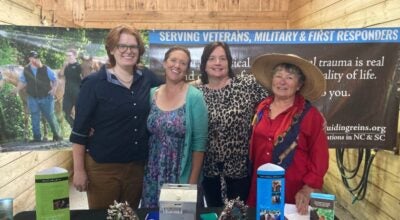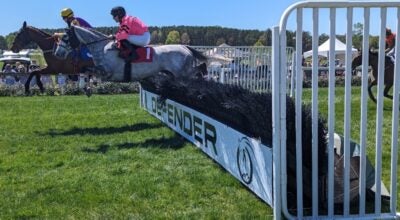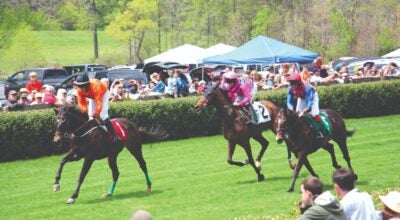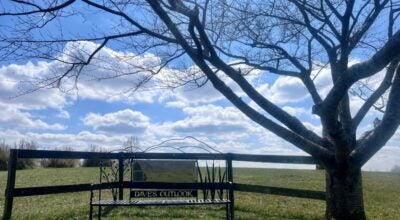How wooden shoes can help your horse
Published 3:58 pm Monday, May 1, 2017
Written and photographed by Judy Heinrich
A step-by-step guide for easing laminitis
With spring well upon us, the thoughts of many horse owners have turned to founder – or more accurately the rotten fear of it.
If you follow news on laminitis or founder, it may be because you’ve had one of your own horses affected by it. And you may have heard about a relatively new treatment approach that uses wooden shoes to relieve laminitis pain and possibly minimize its damaging effects.
Lucky for us, one of our area’s long-time farriers, Jack Montgomery Sr., has dedicated himself to studying, mastering and now using the wooden shoe technique to relieve the pain of laminitis and return horses to soundness. Jack does this for his own clients’ horses and, on a consulting basis, for the clients of other farriers.
Jack says he was intrigued by the wooden shoe technique as soon as he first heard of it. About five years ago he attended a clinic given by one of its earliest practitioners, who is both a master farrier and equine vet, and who has used wooden shoes in hundreds of cases.
And while laminitis is the most common reason for using wooden shoes, Jack says they have also been successfully used for hoof conditions such as thin soles, cracked coffin bones, inflamed bursa, and navicular.
Horse owners are always glad to learn of any new technique for helping horses that are suffering. But, as an important caveat, the purpose of this article is to give readers an overview of the technique and its benefits; it is not intended as a how-to guide. Successful use of wooden shoes requires specialized training, experience and tools. In other words, don’t just try it at home!
Why wood?
“There are a number of benefits to using wooden shoes,” Jack says. “Wood is a non-abrasive material and easy to work with. I can shape the shoe to distribute the horse’s weight differently. And I can adjust and fine-tune as I’m working, to get the correct angles and pressure.
“That enables me to take a foundered horse that is so sore on his toes, and distribute the weight to the back of the foot so that he can walk without pain, if at all possible.”
It takes a team
Jack says that 90 percent of his work doing wooden shoes starts with the client’s veterinarian on hand at the barn to take radiographs. “We can decide exactly what needs to be done because we’re looking at the x-rays and can see if there’s been rotation in the hoof. With the vet there, there’s no guesswork – we know right where the break-over needs to be and how the shoe should fit.”
Also on hand many times is the client’s regular farrier who, having found that traditional shoeing has not helped with a thorny problem, has called Jack in to try the wooden shoes, sometimes as a last resort. This is much the same as a patient’s primary doctor would send them to a specialist for a specific health problem. As in that case, the client and horse return to the regular farrier’s care once the wooden shoes have helped get the horse sound again.
On-site demonstration
To help me understand how wooden shoes are made and applied, Jack set up a demonstration on a local horse he’s worked on for years. Fritz, owned by Don and Peggy Lyons, is actually fit as a fiddle with no hoof problems but Jack knew the big Tennessee Walking Horse was calm and patient enough to be worked on and stand around while I asked questions and got down on the floor to take pictures. Many riders’ lives would be easier if all horses had this one’s brain!
The following describes the primary steps Jack goes through to create and fit wooden shoes for a horse suffering from laminitis, with the descriptions corresponding to the numbered photos. Steps, fitting and techniques may differ for horses suffering from problems other than laminitis.
Local Cases
– Carol Greata’s Franny is a 15-year old Welsh pony that does combined driving, which is a multi-discipline equivalent of eventing. A little over a year ago Franny had an abscess in her right front that wouldn’t heal, which then caused a founder.
Franny’s vet, Kris Woodaman, and regular farrier, Mick Doyle, tried several things, including cushions and Soft-Ride Boots but, Carol says, “As good a farrier as Mick is, nothing was working. So Kris suggested we call Jack in to try his wooden shoes. It was something completely new and kind of experimental, and we all thought it was worth trying.”
Carol said Franny had her wooden “clogs” on for about three rounds of shoeing and briefly had them on all four feet after she developed an abscess on one of her hinds. She has since gone to therapeutic steel shoes on the front and, Carol said, “has been quite sound. We may go back to regular shoes at the next shoeing.
“It’s been a real team effort; Kris has been here every time Jack is here so we know exactly what’s going on in there,” Carol continued. “It’s been worth all the time and effort. Franny is a tough pony but I don’t think she would be here today if we hadn’t done this.”
– Local dressage trainer Sue Terrall’s 16-year old Hanoverian mare Dancer foundered while under treatment for a stifle issue in her right hind. “Her stifle had been injected and she was on a 30-day rehab program with stall rest and hand walking,” Sue explained. “At 28 days she foundered, I think because being stalled was such a big change of routine for her.”
After x-rays showed that Dancer had some rotation, she was put in wooden shoes by Jack, who is her regular farrier. “As soon as they were put on, she was a lot happier,” Sue says. “It was like instant relief.”
Sue says Dancer went through five or six shoeings with the wooden shoes, and then a period with regular shoes and silicon pads. She’s now been in regular shoes for the past four shoeings, remains sound and is back in a slow, progressive training program to re-develop her strength, suppleness and topline.
“Jack has seen me through the whole episode, which has been about a year,” Sue says. “I don’t think I would have this horse today without his good care and good shoeing.”
Pick up a copy of the May 2017 issue of Life in Our Foothills to see the full step-by-step guide.





